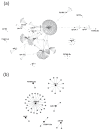Differences in transcription between free-living and CO2-activated third-stage larvae of Haemonchus contortus
- PMID: 20420710
- PMCID: PMC2880303
- DOI: 10.1186/1471-2164-11-266
Differences in transcription between free-living and CO2-activated third-stage larvae of Haemonchus contortus
Abstract
Background: The disease caused by Haemonchus contortus, a blood-feeding nematode of small ruminants, is of major economic importance worldwide. The infective third-stage larva (L3) of this gastric nematode is enclosed in a cuticle (sheath) and, once ingested with herbage by the host, undergoes an exsheathment process that marks the transition from the free-living (L3) to the parasitic (xL3) stage. This study explored changes in gene transcription associated with this transition and predicted, based on comparative analysis, functional roles for key transcripts in the metabolic pathways linked to larval development.
Results: Totals of 101,305 (L3) and 105,553 (xL3) expressed sequence tags (ESTs) were determined using 454 sequencing technology, and then assembled and annotated; the most abundant transcripts encoded transthyretin-like, calcium-binding EF-hand, NAD(P)-binding and nucleotide-binding proteins as well as homologues of Ancylostoma-secreted proteins (ASPs). Using an in silico-subtractive analysis, 560 and 685 sequences were shown to be uniquely represented in the L3 and xL3 stages, respectively; the transcripts encoded ribosomal proteins, collagens and elongation factors (in L3), and mainly peptidases and other enzymes of amino acid catabolism (in xL3). Caenorhabditis elegans orthologues of transcripts that were uniquely transcribed in each L3 and xL3 were predicted to interact with a total of 535 other genes, all of which were involved in embryonic development.
Conclusion: The present study indicated that some key transcriptional alterations taking place during the transition from the L3 to the xL3 stage of H. contortus involve genes predicted to be linked to the development of neuronal tissue (L3 and xL3), formation of the cuticle (L3) and digestion of host haemoglobin (xL3). Future efforts using next-generation sequencing and bioinformatic technologies should provide the efficiency and depth of coverage required for the determination of the complete transcriptomes of different developmental stages and/or tissues of H. contortus as well as the genome of this important parasitic nematode. Such advances should lead to a significantly improved understanding of the molecular biology of H. contortus and, from an applied perspective, to novel methods of intervention.
Figures



Similar articles
-
Identification of differentially expressed proteins between free-living and activated third-stage larvae of Haemonchus contortus.Vet Parasitol. 2016 Jan 15;215:72-7. doi: 10.1016/j.vetpar.2015.10.030. Epub 2015 Nov 10. Vet Parasitol. 2016. PMID: 26790740
-
Molecular alterations during larval development of Haemonchus contortus in vitro are under tight post-transcriptional control.Int J Parasitol. 2018 Aug;48(9-10):763-772. doi: 10.1016/j.ijpara.2018.03.008. Epub 2018 May 22. Int J Parasitol. 2018. PMID: 29792880
-
Gender-enriched transcripts in Haemonchus contortus--predicted functions and genetic interactions based on comparative analyses with Caenorhabditis elegans.Int J Parasitol. 2008 Jan;38(1):65-83. doi: 10.1016/j.ijpara.2007.07.001. Epub 2007 Jul 26. Int J Parasitol. 2008. PMID: 17707841
-
Prospects for exploring molecular developmental processes in Haemonchus contortus.Int J Parasitol. 2006 Jul;36(8):859-68. doi: 10.1016/j.ijpara.2006.04.007. Epub 2006 May 17. Int J Parasitol. 2006. PMID: 16759659 Review.
-
Systems biology of Haemonchus contortus - Advancing biotechnology for parasitic nematode control.Biotechnol Adv. 2025 Jul-Aug;81:108567. doi: 10.1016/j.biotechadv.2025.108567. Epub 2025 Mar 22. Biotechnol Adv. 2025. PMID: 40127743 Review.
Cited by
-
Transcriptome profiling of the fifth-stage larvae of Angiostrongylus cantonensis by next-generation sequencing.Parasitol Res. 2013 Sep;112(9):3193-202. doi: 10.1007/s00436-013-3495-z. Epub 2013 Jul 5. Parasitol Res. 2013. PMID: 23828188 Free PMC article.
-
The transcriptome of Trichuris suis--first molecular insights into a parasite with curative properties for key immune diseases of humans.PLoS One. 2011;6(8):e23590. doi: 10.1371/journal.pone.0023590. Epub 2011 Aug 24. PLoS One. 2011. PMID: 21887281 Free PMC article.
-
Comparative analyses of two Geraniaceae transcriptomes using next-generation sequencing.BMC Plant Biol. 2013 Dec 29;13:228. doi: 10.1186/1471-2229-13-228. BMC Plant Biol. 2013. PMID: 24373163 Free PMC article.
-
Proteomic Analysis of the Excretory and Secretory Proteins of Haemonchus contortus (HcESP) Binding to Goat PBMCs In Vivo Revealed Stage-Specific Binding Profiles.PLoS One. 2016 Jul 28;11(7):e0159796. doi: 10.1371/journal.pone.0159796. eCollection 2016. PLoS One. 2016. PMID: 27467391 Free PMC article.
-
The transcriptome analysis of Strongyloides stercoralis L3i larvae reveals targets for intervention in a neglected disease.PLoS Negl Trop Dis. 2012;6(2):e1513. doi: 10.1371/journal.pntd.0001513. Epub 2012 Feb 28. PLoS Negl Trop Dis. 2012. PMID: 22389732 Free PMC article.
References
-
- Veglia F. The anatomy and life history of the Haemonchus contortus (Rud) Rep Dir Vet Res. 1915;3-4:347–500.
-
- Davey KG, Sommerville RI, Rogers WP. The effect of ethoxyzolamide, an analogue of insect juvenile hormone, nor-adrenaline and iodine on changes in the optical path difference in the excretory cells and oesophagus during exsheathment in Haemonchus contortus. Int J Parasitol. 1982;12:509–513. doi: 10.1016/0020-7519(82)90045-5. - DOI - PubMed
-
- Rogers WP, Petronijevic T. In: Biology and Control of Endoparasites. Symons LEA, Donald AD, Dineen JK, editor. Academic Press, Australia; 1982. The infective stage and development of nematodes; pp. 3–28.
Publication types
MeSH terms
Substances
Grants and funding
LinkOut - more resources
Full Text Sources
Research Materials

